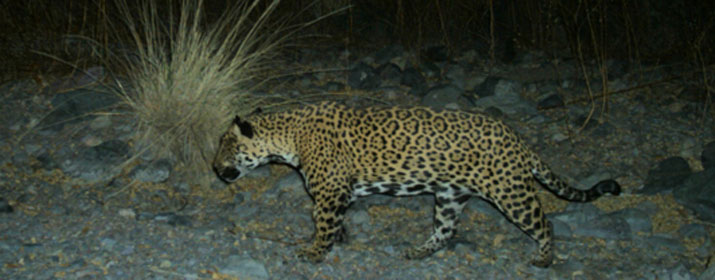
Tucson Electric Power is supporting one local organization’s efforts to preserve wildlife corridors in an effort to bring the rare and elusive jaguar back to Southern Arizona.
Sky Island Alliance’s Path of the Jaguar Project focuses attention on the literal and symbolic journey of this majestic big cat through what are known as the “sky islands” here in the Sonoran Desert region. Sky islands are forested mountain ranges that rise up out of the desert and grasslands. These 55 mountain ranges host a vast diversity of wildlife.
“We launched this campaign three years ago to inspire and engage our community to care about wildland conservation and preserve open spaces and corridors for the jaguar – and all wildlife – so that they can recover, find food and thrive,” explained Louise Misztal, Executive Director of the Sky Island Alliance. “We want to help people to appreciate and understand the connection between wildlife and their habitats and to become advocates.”
Conservationists were thrilled when “El Jefe,” the only jaguar thought to be living in the United States, was caught on a video trail camera in the Santa Rita Mountains near Tucson in 2016. The sighting was as rare as jaguars themselves, with only about 15,000 of the species existing worldwide.
Jaguars could be found throughout the Southwestern U.S., Mexico and Central and South America up until the late 19th century. But their population declined with the loss of habitat from farming, ranching and urban development and predator management policies.
“The jaguar is a maverick animal that needs massive, wide open spaces to roam,” said TEP’s Shannon Breslin, Manager of Land Resources and an advocate for responsible land management and development, who serves on the Sky Island Alliance board. The needs of development and sensitive resources don’t have to be mutually exclusive. TEP and Sky Island Alliance both work effectively to strike that balance.”
TEP’s $10,000 corporate contribution to the Alliance last year is helping them raise awareness of the jaguar’s tenuous future through a public education and outreach campaign that includes community presentations, hands-on activities and collaborations with the U.S. Forest Service and other wildlife agencies.
“A major cost of wildlife monitoring is the people power – training volunteers and having them go into the field. All of the data collected is then analyzed and the results are shared with the community,” said Misztal. “TEP’s investment in this project is helping to protect open spaces and preserve the diversity of wildlife here to ensure their survival.”
The Alliance puts boots on game trails by training volunteers how to place, adjust and monitor trail cameras —similar to the one monitored by Conservation CATalyst and the Center for Biological Diversity that captured El Jefe’s movements. Other Alliance volunteers protect and restore water sources, conserve habitats for pollinators – birds, bats and bees – and remove invasive species to make the land inviting for wildlife.
“We are very interested in migratory patterns in the sky islands between Mexico and the U.S.,” said Breslin. “Placing cameras in state parks and federal forests and on private lands on both sides of the border helps us document wildlife patterns.”
Through the work of Sky Island Alliance and other conservation groups, jaguars are slowly showing signs of recovery. A handful of jaguars – all male – have been documented in southern Arizona in the past few years.
“Our sky islands and the diversity of life they support are such a unique gem,” Misztal said. “We need to do all that we can to protect them.”
This story is part of our ongoing series highlighting one of TEP’s philanthropic focus areas – environmental stewardship. TEP works with non-profit partners to develop invitation-based donation requests for environmental efforts from April-June. Funds come from corporate resources, not customers’ rates. Learn more about donations.






